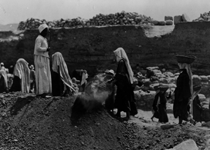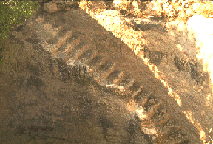Map
| Time
| Climate
| Archaeology
| Glossary
| Bibliography
| Activities
|
Artifacts
appearing in the Museum's Canaan and Ancient Israel
Gallery were drawn from the Museum's
Syro-Palestinian collection of over 15,000
artifacts which came from these archaeological
excavations:
Tel Beth Shemesh
(1928-1933)
Tel Beth Shean
(1921-1933)
Gibeon
(1956-1962)
Tell es-Sa'idiyeh
(1964-1967)
Sarepta
(1969-1974)
the Baq'ah Valley
(1977-1981)
In Canaan and ancient
Israel, archaeological sites are most often mounds,
which have been built up by thousands of years'
worth of habitation in the same place. These mounds
are called tels (in Arabic,
tells).
|

|

|
Tel Beth
Shemesh
Elihu Grant of
Haverford College (Haverford, Pennsylvania)
directed excavations at Beth Shemesh, a seven-acre
tel, or mound, situated about twelve miles west of
Jerusalem, known in the Bible as the birthplace of
Joshua. The Hebrew name apparently preserves the
tradition of an older Canaanite temple. The remains
are from the Middle Bronze Age through the
Byzantine period (1900 BCE to c. 830
CE).
|
|
Tel Beth
Shean
The site of Beth Shean
(Tell el-Husn, modern Beisan) is located on a large
ten-acre mound. Project directors Clarence Fisher,
Alan Rowe, and Gerald FitzGerald excavated eighteen
city levels dating from the Late Neolithic period
(4500 BCE) through the 12th century CE. At the time
of the conquest, according to the Bible, Beth Shean
is one of the cities from which the Israelites did
not rout the Canaanites (Joshua 17:11; Judges
1:27), and the city onto whose walls the
Philistines "fastened" the body of Saul and those
of his sons (1 Samuel 31:10).
|
|
Gibeon

Dr. James B. Pritchard,
the first curator of the Section of Biblical
Archaeology at the Museum directed the excavations
at the biblical city of Gibeon.
|
Then spoke
Joshua to the LORD in the day when the LORD gave
the Amorites over to the men of Israel; and he
said in the sight of Israel, "Sun, stand thou
still at Gibeon, and thou Moon in the valley of
Al'jalon."
Gibeon, the modern Arab
village of el-Jib, was first occupied in the Middle
Bronze Age I as evidenced mainly by its cemetery.
In the Early Iron Age, a massive city wall was
built around the mound and a huge cylindrical pool
for fresh water, reached by a spiraling stair of 79
steps, was excavated in the bedrock. The city
reached its peak in the 7th century BCE when the
entire mound was covered with buildings and the
Gibeonites produced and traded large quantities of
wine (63 rock-cut storage cellars for wine were
excavated).
|
|
Tell es-
Sa'idiyeh
In 1964, Dr. Pritchard
turned his attention to Tell es- Sa'idiyeh. In two
seasons of excavation, he found a cemetery used in
the Late Bronze and Early Iron Age (ca. 1250-1150
BCE) and city remains from the Iron Age (9th-8th
century BCE). The rich burials at Tell es-Sa'idiyeh
contained bronze vessels, jewelry of gold and
precious stones, and beautiful imported and locally
produced pottery.
|

|
Sarepta
Dr. Pritchard then
directed four seasons of excavations at Sarepta
(modern Sarafand) in Lebanon. This important
Phoenician port flourished from its foundation in
about 1600 BCE through the Byzantine era. Several
kilns were discovered at Sarepta which shed great
light on Phoenician pottery
manufacturing.
|
|
The Baq'ah
Valley Project
The Museum's
collections also include artifacts from five
seasons of survey and excavation in the Baq'ah
Valley (between 1977-1987), nine miles northwest of
Amman, Jordan. Dr. Patrick E. McGovern, Senior
Research Scientist in the Museum Applied Science
Center for Archaeology (MASCA), directed excavation
and survey at several different tels and burial
caves, discovering artifacts dating as far back as
the Early Bronze Age. Among the significant
discoveries were a large Late Bronze Age cult
building and one of the largest tombs from the
Early Iron Age (1200-1050 BCE) excavated in the
area.
|
|
The University of Pennsylvania was
among the first American universities to conduct
large-scale excavations in the Middle East. Today,
the Museum still plays a major role in research and
fieldwork in this area with two ongoing projects:
the 3rd millennium BCE site of
Tell es-Sweyhat in northern Syria
(1989-present) under the direction of Dr. Richard
Zettler, Associate Curator in Charge of the Near
East Section, and Khirbat Mudaynat 'Aliya, Jordan
(1994-present), under the direction of Dr. Bruce
Routledge, curator of this exhibition.
|
|

